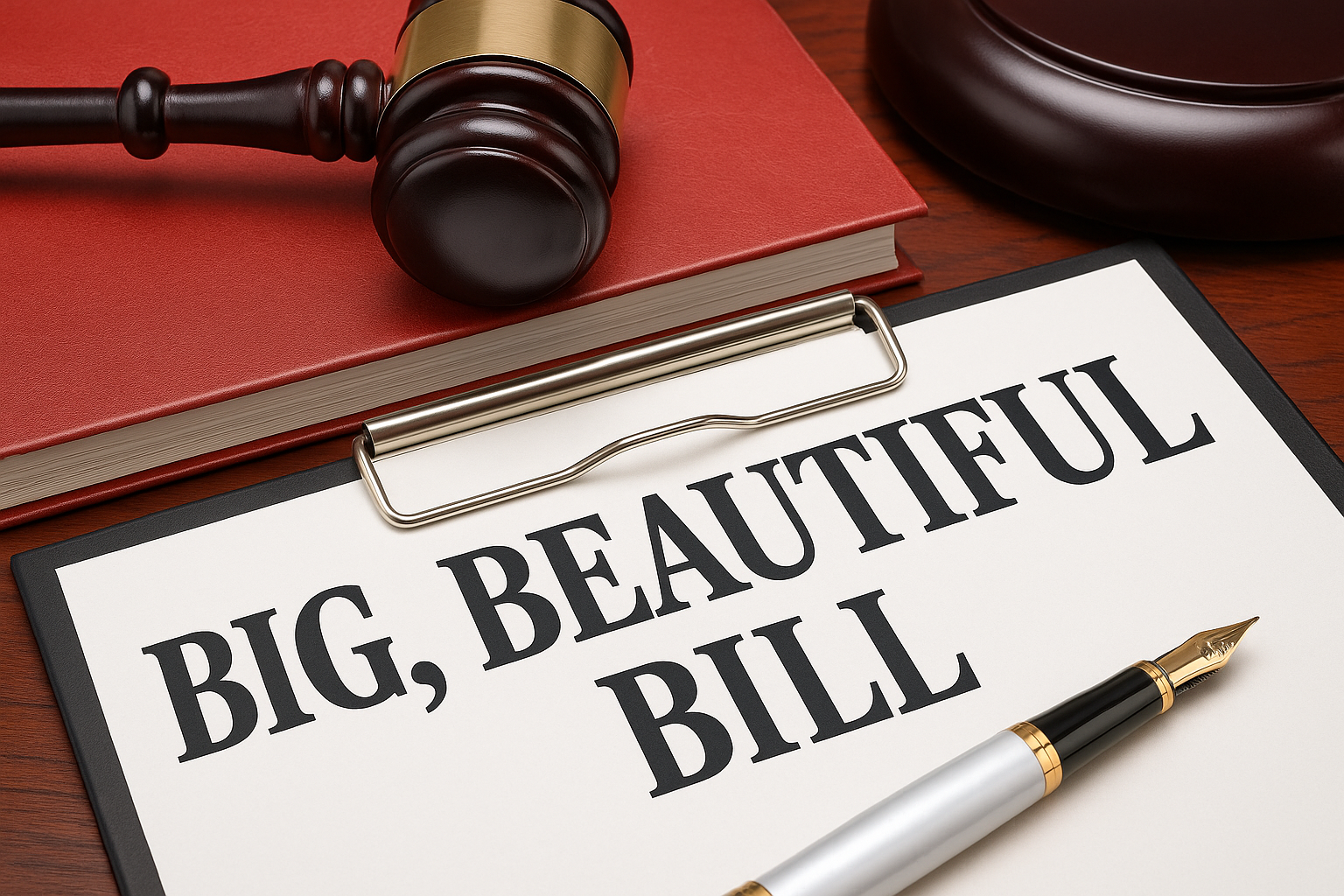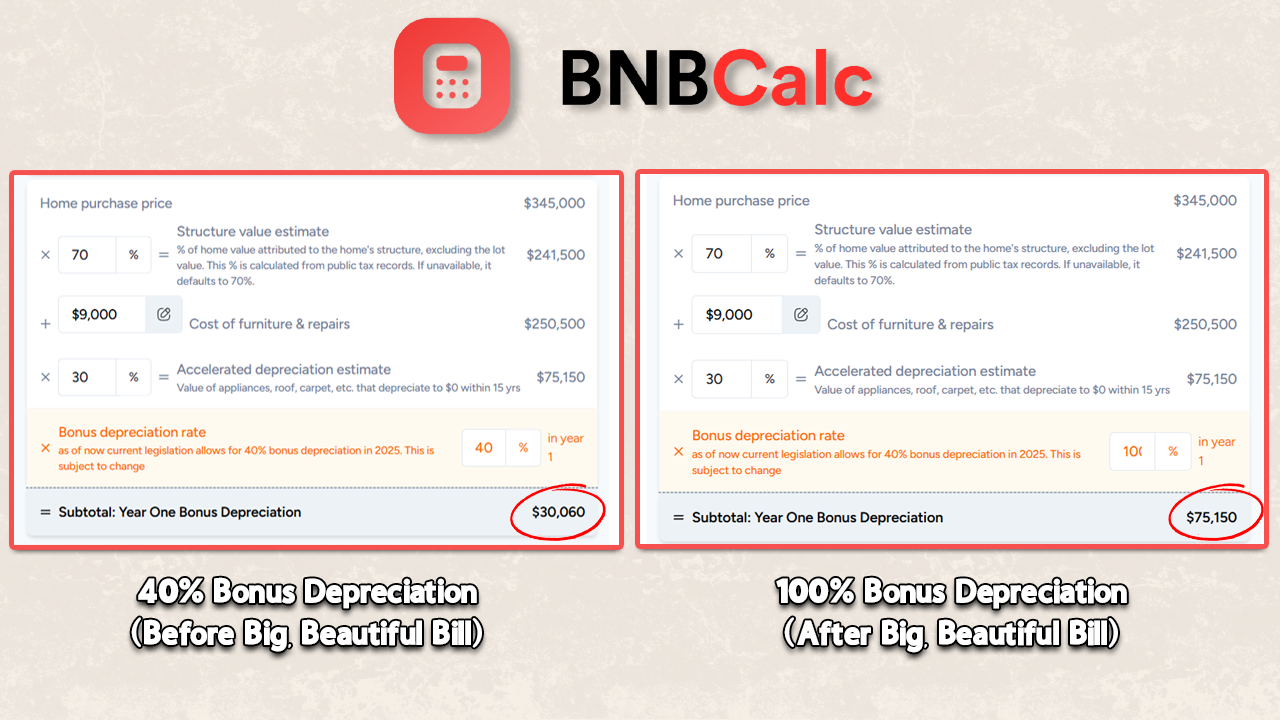Back
Big, Beautiful Bill Passes: How It Can Nearly Triple Your Airbnb Tax Deduction

Written by:
Jeremy Werden
July 7, 2025

⚡️
Reveal any property's Airbnb and Long-Term rental profitability
Buy this property and list it on Airbnb.
The Big, Beautiful Bill, which is bringing back 100% bonus depreciation, has officially passed the House and Senate. President Trump then made it official by inking the legislation during the Independence Day celebrations.
This new legislation brings significant changes to tax policies and business deductions. It shifts the regulatory landscape, directly impacting both short-term rental and long-term rental owners like you.
So, find out how the Big, Beautiful Bill and the 100% bonus depreciation comeback can help you save thousands on taxes and jumpstart your rental growth.
Why the Big, Beautiful Bill Matters For Hosts?
The most important part of this bill for hosts and investors is the comeback of full 100% bonus depreciation. Write off qualifying property components, renovations, and furnishings faster through bonus depreciation and cost segregation strategies. That’s huge for cash flow and growth acceleration.
It’s a powerful (and totally legal) way to reduce your W-2 or 1099 taxes through real estate.
The 100% bonus depreciation applies to eligible purchases retroactive to January 20, 2025, extending through December 31, 2029.
The 20% Small Business Deduction (QBI) is also now permanent, and even bumps up to 23% for many, with expanded eligibility. This means more of your rental income stays in your pocket and no more looming tax increases when previous provisions were set to expire. Not all hosts and owners can qualify for the QBI, though, so check your eligibility.
Overall, the bill returns to more favorable rules for deducting business interest expenses, allowing you to add back depreciation and amortization. This also increases the amount of interest you can deduct.
How 100% Bonus Depreciation Works for Your Airbnb
Bonus depreciation allows you to write off the cost of qualifying property (including certain renovations, furniture, appliances, and equipment) in the first year you place it in service, rather than depreciating it over many years.
Previously, the Tax Cuts and Jobs Act of 2017 introduced this benefit, but it began phasing out after 2022. The Big, Beautiful Bill reinstates 100% Bonus Depreciation, giving real estate investors and STR operators a renewed chance to dramatically reduce taxable income.
However, not everything qualifies for 100% bonus depreciation. Assets eligible for bonus depreciation include tangible personal property with a recovery period of 20 years or less under MACRS (Modified Accelerated Cost Recovery System), such as furniture, appliances, and certain building improvements.
For Airbnb hosts, this covers items like beds, sofas, refrigerators, and even some structural improvements, provided they meet IRS criteria for “qualified improvement property” (QIP).
To take advantage of 100% bonus depreciation, you must meet specific IRS requirements:
- Business Classification: Your Airbnb operation must qualify as a business, meaning it is operated with the intent to make a profit. Short-term rentals typically qualify if rented for more than 14 days annually, and personal use is limited.
- Active Management: You must actively manage the property (handling bookings, maintenance, and guest communications), though hiring a property manager does not disqualify you.
- Qualifying Property: Only assets with a MACRS recovery period of 20 years or less qualify. This includes most furniture and appliances used in your Airbnb, as well as certain interior improvements like flooring, lighting, or non-structural renovations. However, the building itself or structural components (roofs, exterior walls) generally do not qualify unless they meet QIP standards.
- Taxable Income: The deduction is most beneficial if you have sufficient taxable income to offset. If your Airbnb generates a loss, you may need to carry forward the deduction to future years, subject to net operating loss (NOL) rules.
As mentioned, not all purchases can fall under bonus depreciation, and it will be hard to identify them alone. The magic happens through cost segregation studies, which identify components of your property that have shorter depreciation schedules (20 years or less) and therefore qualify for bonus depreciation.
While cost segregation studies can cost thousands of dollars, they are worth every penny if you can save more in taxes as a result.
The Impact of Big, Beautiful Bill Vs Previous Depreciation Deductions
To help you visualize just how big of tax savings you can get because of the passing of the Big, Beautiful Bill, we’ve come up with a scenario.
For example, you currently have an annual income of $125,000. This puts you in the 24% tax rate range. With some quick maths, $125,000 x 24% = $30,000. You’ll owe $30,000 in taxes.
Now, say you just bought a new investment property at $345,000. It’s a 3-bed, 2-bath home that brings in $33,125 in Operating Income, before Mortgages and Taxes.
Now that we’ve got our values laid out, let’s calculate the year one bonus depreciation before and after the Big, Beautiful Bill was passed and compare.
Example Calculation
First, you’ll have to separate the land value from the home’s value. Let’s say the home’s structure is worth 70% of the purchase price. At the $345,000 purchase price, this amounts to $241,500. From here, you can also add the total costs of furniture and repairs. In this case, the total was $241,500 (structure value) + $9,000 (furniture and repairs) = $250,500.
Next, you’ll need to do a cost segregation study. Say this study reveals that 30% of the structure qualifies for accelerated depreciation. This translates to $250,500 (total structure value + furniture and repairs) x 30% = $75,150 of accelerated depreciation.
Before the Big, Beautiful Bill was passed, the Bonus Depreciation Rate was 40% in 2025. This means that you can claim 40% of the $75,150 in year one. This translates to $75,150 x 40% = $30,060 of claimable year one bonus depreciation.
However, since the Big, Beautiful Bill is bringing back the full 100% Bonus Depreciation Rate, you can now claim the full $75,150 in year one, instead of only 40% of it.

Additionally, you can claim other deductions on top of the bonus depreciation.
- The remaining accelerated depreciation over a 10-year schedule
- Standard Depreciation, which is 70% of the structure value over a 39-year schedule
- Mortgage interest payments
- Furniture and Repair Setup Costs
At the previous 40% Bonus Depreciation Rate, your total deductions for year one would be as follows:
(Accelerated depreciation + Standard Depreciation + Mortgage Interest Payments + Furniture and Repair Costs + Bonus Depreciation) – Profit from the property = Total Annual Income Deduction
However, with the new 100% Bonus Depreciation rate the formula changes to:
(Standard Depreciation + Mortgage Interest Payments + Furniture and Repair Costs + Bonus Depreciation) – Profit from the property = Total Annual Income Deduction
If you have noticed, the accelerated depreciation has been removed since you’re already claiming the full 100% in year one.
Now comes the fun part. The tax bill and the total estimated tax savings. For this, we need the following formula:
(Total Annual Income – Total Annual Income Deduction) x Income Tax Rate = New Tax Bill
In this scenario, the esimated tax savings are:
- Estimated Tax Savings at 40% Bonus Depreciation: $30,000 - $23,864 = $6,136
- Estimated Tax Savings at 100% Bonus Depreciation: $30,000 - $14,124.24 = $15,875.76
That’s 2.59 times more tax savings for this scenario. That’s why the comeback of 100% bonus depreciation is so valuable to hosts and investors in America.
I know how long those calculations took. However, you can quickly estimate yours for properties on your radar by using our free built-in tax calculator. You’ll see one under every analysis for each property.
Wrapping Things Up
The reinstatement of 100% bonus depreciation through the Big, Beautiful Bill is a game-changer for Airbnb hosts, offering significant tax savings that can enhance cash flow and jumpstart your investment.
Whether you’re eyeing your first rental property or expanding an existing portfolio, now is the time to take advantage of these renewed tax incentives.
Disclaimer: This article provides general information about the Big, Beautiful Bill and the 100% bonus depreciation policy within it. It should not be construed as tax, legal, or financial advice. Tax policies are subject to change, implementation details may vary, and application to your situation is not guaranteed. Consult with a qualified tax professional regarding your specific situation before making any business or investment decisions based on the legislation. We assume no liability for actions taken based on this content.
⚡️
Reveal any property's Airbnb and Long-Term rental profitability
Buy this property and list it on Airbnb.